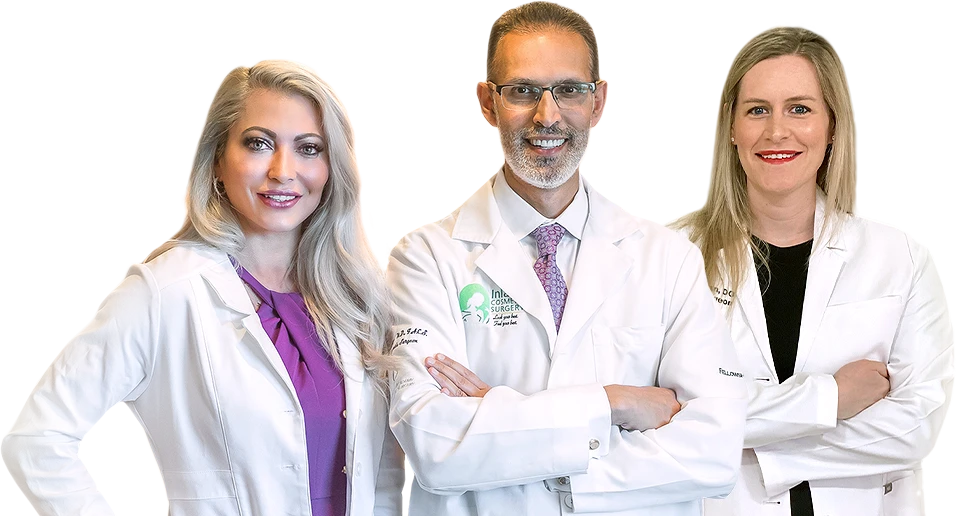9 Questions You Have About Breast Implant Removal, Answered by Cosmetic Breast Surgeons

Are you ready to part ways with your breast implants? We get it. Things change, and if you are at the point where having augmented breasts no longer suits your needs, we bet you have a lot of questions about breast implant removal — our patients certainly do!
Scouring the internet for reliable answers can be daunting (not to mention confusing), so our Rancho Cucamonga cosmetic surgeons have decided to answer some of the more frequently asked questions (and a few unique ones) about breast implant removal for you today.
1. Why is everyone removing their breast implants?
Well, not everyone is doing it — breast augmentations still significantly outnumber implant removals year after year, both in our practice and in the U.S. as a whole — but implant removal procedures are gaining more interest. Evolving aesthetic trends are a factor; we’ve seen a decline in desire for large augmentations for some years now, and some patients who wanted that look 10 or 15 years ago now do not.
2. What are good reasons for breast implant removal?
A “good” reason is different for everyone; if you don’t want breast implants anymore, that is reason enough. However, common reasons for implant removal include:
- Complications such as capsular contracture, implant rippling, implant deflation or rupture, and other aesthetic issues.
- Concerns over conditions such as breast implant illness and breast implant-associated large cell lymphoma (BIA-ALCL). While rare, heightened awareness of these complications have been better documented in recent years, naturally leading to increased patient concerns about their implants.
- Bodies change. Breast augmentation can boost your appearance, but it can’t make it immune to the effects of time. Pregnancy, breastfeeding, and aging all affect the shape and density of natural breast tissue, leading to sagging and other issues that lead patients to want their implants removed.
3. How are breast implants removed?
The basic procedure to remove breast implants is called explantation. The cosmetic surgeon will make a small incision — typically using the scar site from the original breast augmentation — and remove the implant through this incision. Sometimes it’s that simple, but often we need to complete a few extra steps to achieve the desired result.
Like any cosmetic surgery, implant removal must be tailored to the individual’s needs. For example, some patients benefit from a total capsulectomy, which removes the entire capsule of scar tissue that forms around the implant. This is called for to treat complications such as capsular contracture, which causes excessive tightening of the scar capsule, and for patients concerned about breast implant illness. To treat known or suspected BIA-ALCL, an “en bloc” total capsulectomy, in which the capsule is removed with the implant still inside it to keep any abnormal cells contained, is often recommended.
A simple capsulotomy, or partial capsulectomy, which leaves some or all of the scar tissue intact, can be a great option for patients who aren’t having issues with the capsule. This technique results in a quicker procedure, usually with a quicker recovery time.
4. Do I need an en bloc capsulectomy?
You can find plenty of advice on the internet that en bloc capsulectomy is “the best” because it “gets everything.” However, it is a more involved procedure with some additional risks. If the capsule is surrounded by thin or delicate tissue, or is more tightly adhered to the chest muscle, en bloc removal can increase risk of bleeding or tissue damage. It also requires longer scars. We recommend en bloc removal for patients when the benefits outweigh the risks, but for many, it’s actually not the best option.
Recent studies suggest that an en bloc capsulectomy is not necessary to see improvement in BII symptoms.
More importantly, in recent published studies of breast implant illness, the patients reported improvement in their symptoms after implant removal regardless of the patient having total capsulectomy, partial capsulectomy, or even no capsulectomy.
5. What are the symptoms of breast implant illness?
Breast implant illness (BII) has gained attention in recent years, largely due to increased patient and physician reporting, and naturally many patients wonder if they’ll be better off without implants. We don’t yet have good statistics, but BII seems to affect only a small percentage of people with breast implants overall. Symptoms can include:
- Unexplained fatigue
- Headache or migraine
- Joint pain
- Brain fog or cognitive issues
- Rashes and skin sensitivities
- Depression
- Hair thinning
- Chronic flu-like symptoms
As you can see, these symptoms mirror those of many other conditions, so if you think you might have breast implant illness, make an appointment with your primary care physician to rule out other issues. If symptoms persist and no other cause can be identified, a qualified cosmetic surgeon can help you decide whether removing your implants is right for you.
6. Can implants be removed through the belly button if I had TUBA breast augmentation?
TUBA, or transumbilical breast augmentation, places incisions in the navel to avoid scarring on the breasts or armpits. The implants are tunneled under the skin and fat layer, and placed in the breast pockets. When a capsulectomy is not required, we can typically remove saline implants via this same path. Dr. Haiavy has removed and replaced implants through the belly button. He has even replaced saline with silicone implants through the belly button incision.
However, if complications such as an implant rupture or capsular contracture are present, an inframammary (under the breast) incision or a periareolar (around the areola) incision is usually required for a safe and successful outcome.
7. Does skin shrink after breast implant removal?
Skin may or may not shrink back to its original condition after implants are removed, depending on several factors: implant size, the patient’s natural skin elasticity, whether or not they had any pregnancies, and age. In younger patients with good skin elasticity who had modest sized implants, breasts will often return almost to their pre-augmented state within a couple of months. Those with significant breast sagging, thinner skin, or who have had their implants for several decades will often have some loose skin after implants are removed. Having a breast lift at the same time as explant can help with this, and allow the surgeon to create a firmer, symmetrical breast in the process.
8. Is explant ever covered by insurance?
If your implants were placed during a cosmetic breast augmentation, removal will probably not be covered. Some plans may cover implant removal to treat complications such as capsular contracture, but many will not. The one case where insurance may be required to cover an explant is to remove implants originally placed during a breast reconstruction. All that said, insurance policies vary widely in what they will cover, so it is worth checking with yours before scheduling surgery — just don’t expect much.
9. How much does it cost to remove breast implants in California?
Breast implant removal pricing can vary wildly, depending on the surgeon and the extent of the procedure. A total capsulectomy with breast lift will cost significantly more than a simple implant removal through the original scars.
Never pick a surgeon based on price alone: Much more important is that the surgeon has proven experience in the explant procedure you are considering, operates in accredited facilities with qualified support staff, and is someone you trust to achieve your desired result.
There is usually a way to make cosmetic surgery affordable; we’ve helped many of our Inland Empire breast implant removal patients obtain low or even no interest financing for their procedures.
Let us be your Rancho Cucamonga breast implant removal resourceWe hope we’ve answered some of your burning questions, but we’re here to help if you have more! Our cosmetic surgeons Dr. Jacob Haiavy, Dr. Irene Tower, and Dr. Emma Ryan would be glad to help answer your questions at an in-person or virtual private consultation. Give us a call at 909-707-4899 or contact us online today.
